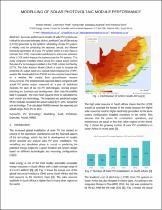JavaScript is disabled for your browser. Some features of this site may not work without it.
- ResearchSpace
- →
- Research Publications/Outputs
- →
- Conference Publications
- →
- View Item
| dc.contributor.author |
Mkasi, Hlaluku W

|
|
| dc.contributor.author |
Lawrence, Pratt

|
|
| dc.contributor.author |
Ayanna, Manjunath B

|
|
| dc.contributor.author |
Roro, Kittessa T

|
|
| dc.date.accessioned | 2022-03-13T17:36:20Z | |
| dc.date.available | 2022-03-13T17:36:20Z | |
| dc.date.issued | 2021-11 | |
| dc.identifier.citation | Mkasi, H.W., Lawrence, P., Ayanna, M.B. & Roro, K. 2021. Modelling of solar photovoltaic module performance. http://hdl.handle.net/10204/12322 . | en_ZA |
| dc.identifier.isbn | 978-0-7972-1878-9 | |
| dc.identifier.uri | http://hdl.handle.net/10204/12322 | |
| dc.description.abstract | The high demand for low carbon energy and rapidly decreasing solar panel prices have led to a surge in solar photovoltaic (PV) plants across the globe, more than at any other time since the industry began. Combined with geographic variations in environmental conditions, this has led to a vast increase in the need for characterisation of local spectral data. However, obtaining site-specific spectral data can be difficult for average users due to their high cost, varying accuracy, and difficulty to operate and maintain. Currently, users work with spectral data obtained from the American Society for Testing and Materials (ASTM) standard, satellites, and the Simple Model for Atmospheric Transmission of Sunshine (SMARTS) Model. To describe spectra generated by any of the above-mentioned sources, researchers have used average photon energy (APE) and other parameters. In this paper, we develop a method for describing PV site-specific clear sky 12-noon spectral data based on environmental conditions and spectral properties. The approach bins measured spectra into 100 and 200 nm wavelength ranges and characterises their changes throughout the year with the plane of array (PoA) irradiance, APE, air mass (AM) and sun elevation at the site to establish relationships. The method developed showed strong correlations between the APE and the PoA irradiance, the AM and the sun elevation in three clear sky days, each month over the period of three years. The observed strong correlations between these parameters indicate that when spectra cannot be measured, the measurable site’s environmental conditions can help determine the spectral content with strong confidence. | en_US |
| dc.format | Fulltext | en_US |
| dc.language.iso | es | en_US |
| dc.source | Southern African Sustainable Energy Conference, Lanzerac, Western Cape, 17-19 November 2021 | en_US |
| dc.subject | Air mass | en_US |
| dc.subject | Average photon energy | en_US |
| dc.subject | Binning | en_US |
| dc.subject | Plane of array irradiance | en_US |
| dc.subject | Sun elevation | en_US |
| dc.subject | Spectral distribution | en_US |
| dc.subject | Solar photovoltaic plants | en_US |
| dc.title | Modelling of solar photovoltaic module performance | en_US |
| dc.type | Conference Presentation | en_US |
| dc.description.pages | 7 | en_US |
| dc.description.note | Paper presented at Southern African Sustainable Energy Conference, Lanzerac, Western Cape, 17-19 November 2021 | en_US |
| dc.description.cluster | Smart Places | en_US |
| dc.description.impactarea | Energy Supply and Demand | en_US |
| dc.identifier.apacitation | Mkasi, H. W., Lawrence, P., Ayanna, M. B., & Roro, K. (2021). Modelling of solar photovoltaic module performance. http://hdl.handle.net/10204/12322 | en_ZA |
| dc.identifier.chicagocitation | Mkasi, Hlaluku W, Pratt Lawrence, Manjunath B Ayanna, and Kittessa Roro. "Modelling of solar photovoltaic module performance." <i>Southern African Sustainable Energy Conference, Lanzerac, Western Cape, 17-19 November 2021</i> (2021): http://hdl.handle.net/10204/12322 | en_ZA |
| dc.identifier.vancouvercitation | Mkasi HW, Lawrence P, Ayanna MB, Roro K, Modelling of solar photovoltaic module performance; 2021. http://hdl.handle.net/10204/12322 . | en_ZA |
| dc.identifier.ris | TY - Conference Presentation AU - Mkasi, Hlaluku W AU - Lawrence, Pratt AU - Ayanna, Manjunath B AU - Roro, Kittessa AB - The high demand for low carbon energy and rapidly decreasing solar panel prices have led to a surge in solar photovoltaic (PV) plants across the globe, more than at any other time since the industry began. Combined with geographic variations in environmental conditions, this has led to a vast increase in the need for characterisation of local spectral data. However, obtaining site-specific spectral data can be difficult for average users due to their high cost, varying accuracy, and difficulty to operate and maintain. Currently, users work with spectral data obtained from the American Society for Testing and Materials (ASTM) standard, satellites, and the Simple Model for Atmospheric Transmission of Sunshine (SMARTS) Model. To describe spectra generated by any of the above-mentioned sources, researchers have used average photon energy (APE) and other parameters. In this paper, we develop a method for describing PV site-specific clear sky 12-noon spectral data based on environmental conditions and spectral properties. The approach bins measured spectra into 100 and 200 nm wavelength ranges and characterises their changes throughout the year with the plane of array (PoA) irradiance, APE, air mass (AM) and sun elevation at the site to establish relationships. The method developed showed strong correlations between the APE and the PoA irradiance, the AM and the sun elevation in three clear sky days, each month over the period of three years. The observed strong correlations between these parameters indicate that when spectra cannot be measured, the measurable site’s environmental conditions can help determine the spectral content with strong confidence. DA - 2021-11 DB - ResearchSpace DP - CSIR J1 - Southern African Sustainable Energy Conference, Lanzerac, Western Cape, 17-19 November 2021 KW - Air mass KW - Average photon energy KW - Binning KW - Plane of array irradiance KW - Sun elevation KW - Spectral distribution KW - Solar photovoltaic plants LK - https://researchspace.csir.co.za PY - 2021 SM - 978-0-7972-1878-9 T1 - Modelling of solar photovoltaic module performance TI - Modelling of solar photovoltaic module performance UR - http://hdl.handle.net/10204/12322 ER - | en_ZA |
| dc.identifier.worklist | 25453 | en_US |






